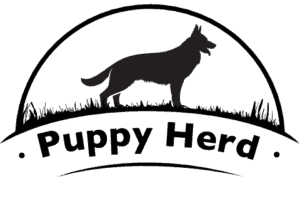German Shepherds are big dogs, and some love playing rough. They enjoy chasing and being aggressive towards other animals, but they also love playing with them. So, are German Shepherds actually good with small animals?
The German Shepherd’s instincts are to herd, protect and chase, and being good with small animals does not come naturally for many. But a German Shepherd with proper socialization and training will have no problem getting along with small animals.
Dominance, protecting territory, and aggressive behavior can give the German Shepherd Dog a bad rep with small animals. But there are ways to train your German Shepherd to co-exist with small animals, including other dogs, cats, chickens, hamsters, and small pigs.
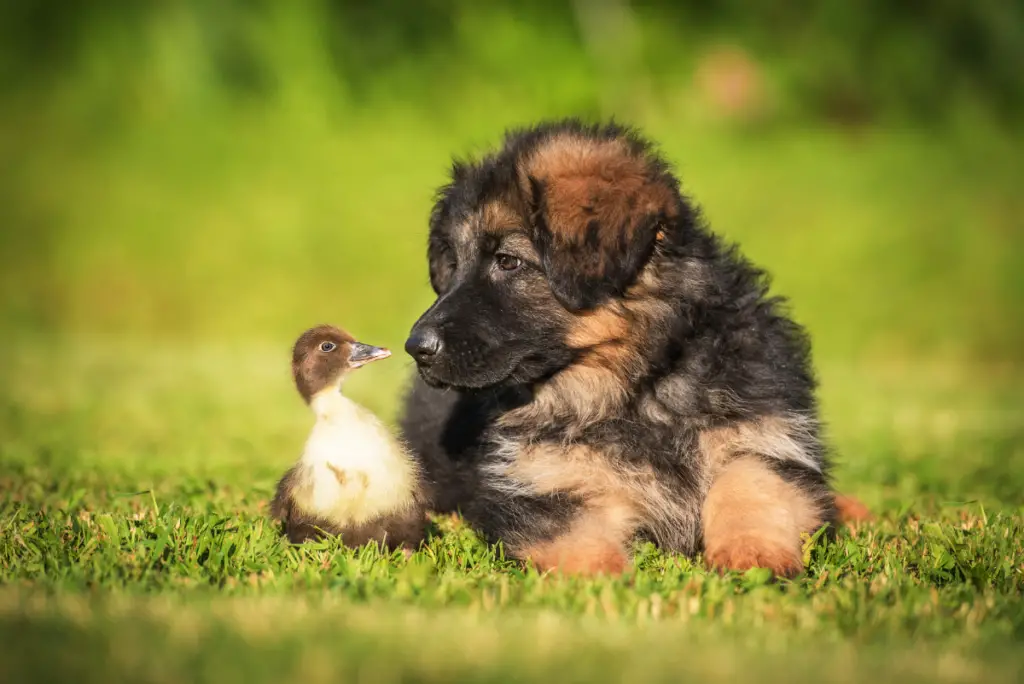
Why Would German Shepherds And Small Animals Not Get Along?
The German Shepherd is a herding breed and has a strong prey drive. The breed’s instincts are to herd, protect and chase. It can be in their nature to chase small animals like rabbits and cats. Even when they don’t always mean any harm, the small animal can get hurt or killed even when the chasing is playful.
The prey drive is a dog’s instinct and varies between dog breeds. The German Shepherd’s prey drive is herding and chasing in order to keep its livestock gathered and safe. That’s why the German Shepherd is a very protective breed and can attack small animals to protect its territory or owner. However, this is only a reason if the dog shows this aggressive trait toward other bigger animals, since small animals usually aren’t a significant threat.
A herding dog has an instinctive dominance over its herd and territory. An over-dominant German Shepherd will then instinctively seek dominance over small animals, like cats and small dogs.
Signs of dominance can be that the dogs ignore your commands by staring, growling, barking, or trying to bite you. An over-dominant dog is apparent when asking the dog to give up toys or food.
A lack of exposure could also explain why a German shepherd does not get along with small animals. If the dog doesn’t have any prior encounters with small animals, it will act according to instinct rather than trained behavior.
Does A German Shepherd’s Personality Play A Role?
Dogs are different from one another. Some are calmer, and others are more active and playful. A dog’s characteristic plays a role in how fast and obedient the dog is to its training.
A strong German Shepherd drive has been very beneficial in areas like athletics, personal protection, and police work. The drive will be apparent when the dog’s human partner is threatened or when the dog seeks a missing person. German Shepherds are, in general, very obedient, but this drive is not sought after in training them to get along with small animals.
German Shepherds who are calmer and lack drive can be trained more quickly to be good with small animals. Despite the difference in characteristics, mostly all German Shepherds need some training to be good with small animals. Proper training can very efficiently remove the reasons for a German Shepherd to hurt small animals.
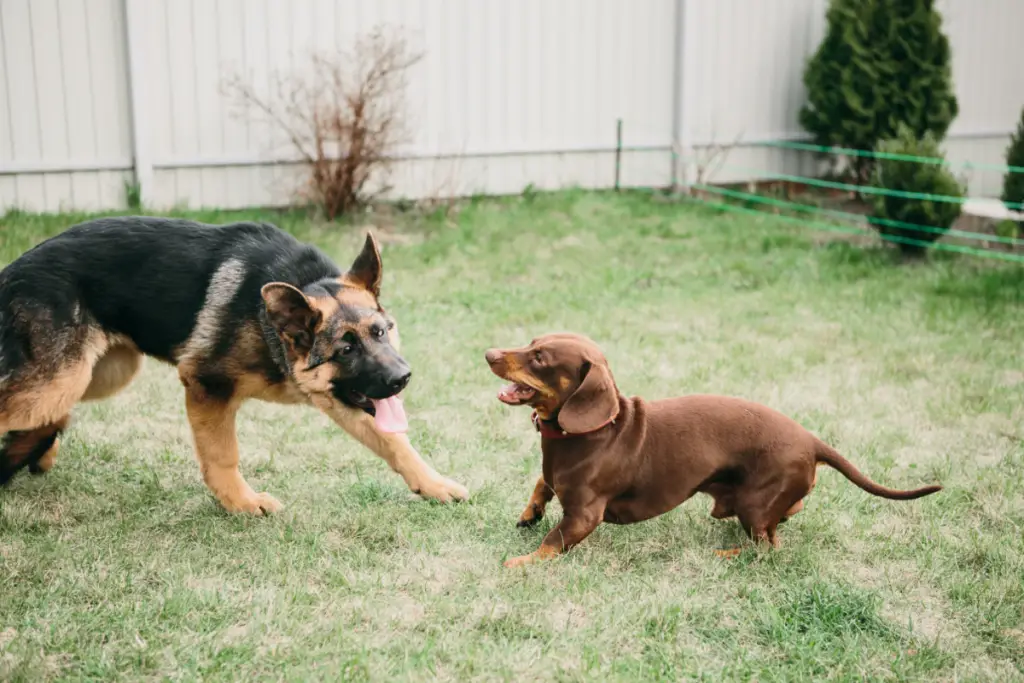
How To Help Your German Shepherd Get Along With Small Animals
The training goal is to have the German Shepherd not paying attention to the small animal at all. This can be achieved in many ways, but here are some useful tricks:
- Start your training with a leash to gain more control over your dog. Give simple commands like “sit” or “lie down” to get the dog’s attention. We want the dog to pay full attention to you instead of to the small animal.
The dog needs to know what to do instead of attacking or chasing the animal. To get the dog to sit, you can raise a treat above its head, and the dog will sit naturally. Reward the dog and repeat until the dog can sit when hearing you say “sit.” - The next step is for the dog to listen to you while having other animals around. Give the same command while having other animals that the dog is already used to around.
This way, you can make sure that your dog listens to you even with distractions around. Introduce the dog to small animals once you know that your dog can obey your command. - When introducing the dog to new small animals, you want to decrease the distance between them slowly. Start with just having the small animal in the same room. Only bring the small animal closer once you have seen that your dog has its full attention on you.
Continue to have the dog sit or stay while the small animal comes closer to them. Not the other way around. We want the dog to be comfortable with the small animal moving around them. You might even want to consider using a muzzle to be extra careful.
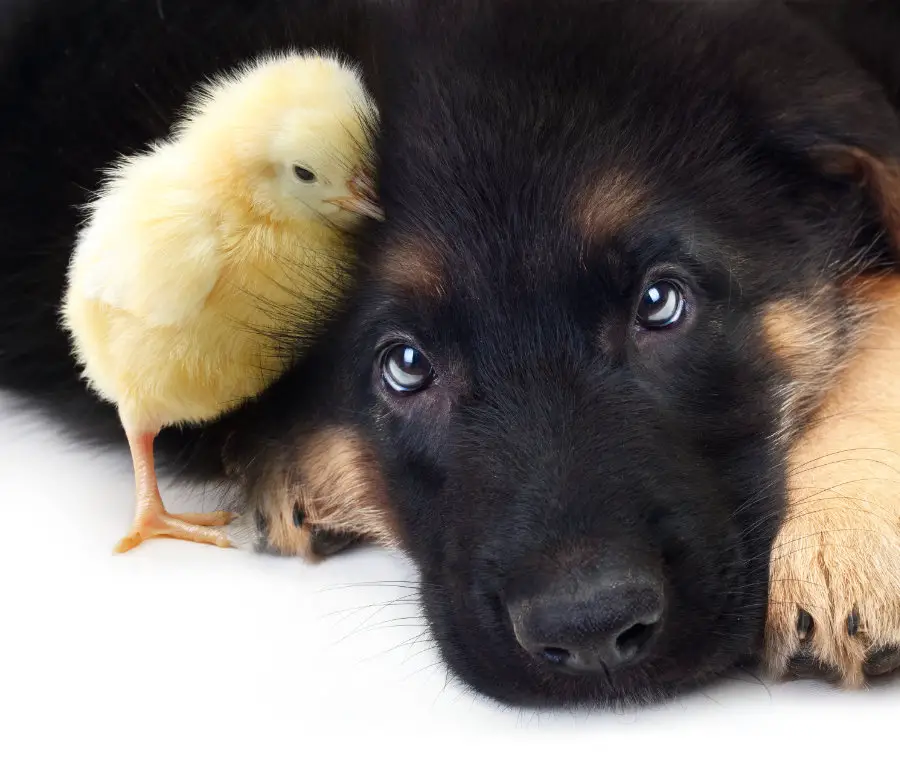
Training Your German Shepherd [Useful Facts To Keep In Mind]
A German Shepherd learns fast as a puppy, so start training them early on. Teach the puppy that aggressiveness and dominance are not tolerated. This will help your dog to behave in other situations other than with small animals too.
However, you want to introduce some small animals a bit later, like chickens, for example. The pup will also remember a bad impression, and the chicken’s behavior can be hard to control. So, wait until you can tell that your dog wants to please its owner, and then you can start training them to be around certain small animals.
You know your dog and how to read the situation best. Take note of your dog’s body language. Usually, when introducing the dog to chicks, your dog will lick its lips, salivate and prepare to bite. Reward the dog when sitting still, calmly, waiting, and not drooling. Be strict and tell the dog when it makes the wrong move or tries to bite the small animal.
Repeat until you can trust your dog before taking the leash off. There is no rush, so take your time before taking risks. Try to always be around your German Shepherd and small animal in the beginning because even well-trained dogs can have accidents when playing.
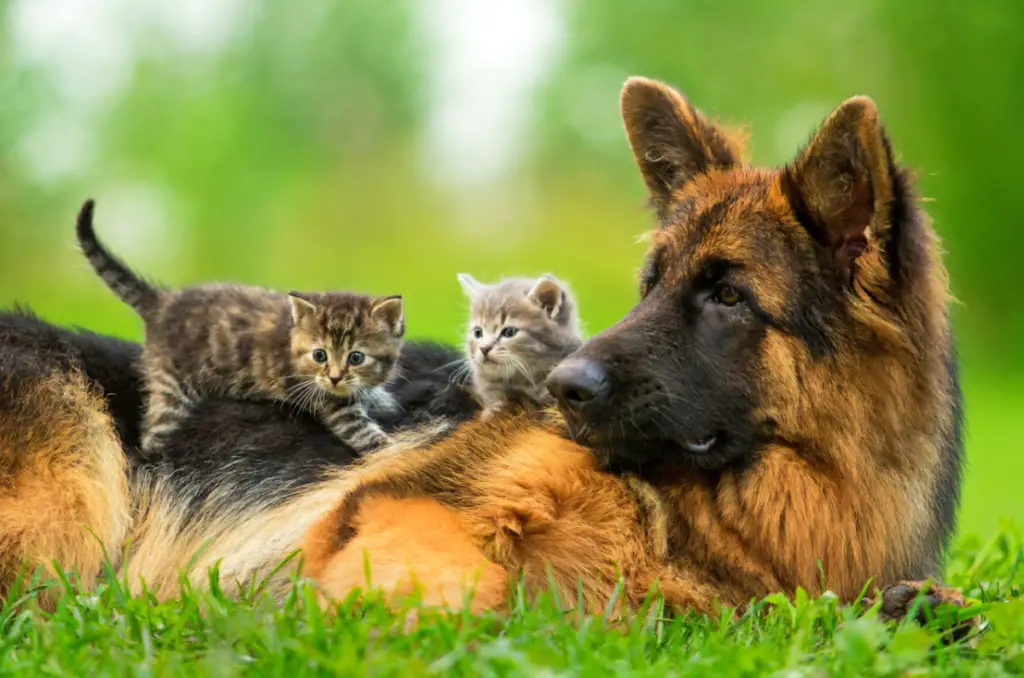
How Do German Shepherds Get Along With Different Small Animals?
- Small dogs can and should be introduced early on. Ideally, the introduced dog should be friendly and calm to make a good first impression. If your German Shepherd is older, you need to take more precautions since it is bigger.
- Cats should and can be introduced early on. German Shepherds can get along well with cats if trained to do so. Again, choose a cat that is already getting along with dogs and if the dog is older, then take it slow and careful. Scent-swapping might be something you want to try if both animals need to get used to each other.
- Pet rabbits and German Shepherds have it harder to co-exist. There are cases where they are good together, but many say that it is easier and safer to separate them. You can train your German Shepherd to ignore the rabbit in its cage, but it gets trickier when they run free in the same space. Never leave them unsupervised.
- Chickens should be introduced when the German Shepherd is a little older because they can pick on the pup and leave marks. Be careful when training them, and after training, they can co-exist. But don’t leave them alone.
- Hamsters should only be introduced to a German Shepherd carefully. But again, there is no way they can’t get along if you train your dog right. A German Shepherd can be so respectful even to the smallest animals.
- Small pigs and German Shepherds can also get along well. Just make sure that your dog has received its training and stays calm.
Final Thoughts
A German Shepherd has many strengths that follow its prey drive. This breed is very obedient when appropriately trained and can absolutely be good with small animals.
When introducing a new small animal to your German Shepherd, be careful and keep both animals safe. This breed has instincts to chase and protect, so teaching them to do something different will take time. How much time depends on the dog and its individual characteristics.
Every kind of small animal needs to be introduced in slightly different ways. But they can all get along with successful training and stay safe with a well-behaved German Shepherd.
